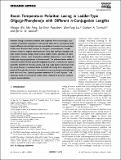Files in this item
Room temperature polariton lasing in ladder-type oligo(p-phenylene)s with different π-conjugation lengths
Item metadata
| dc.contributor.author | Wei, Mengjie | |
| dc.contributor.author | Fang, Mei | |
| dc.contributor.author | Rajendran, Sai Kiran | |
| dc.contributor.author | Lai, Wen-Yong | |
| dc.contributor.author | Turnbull, Graham A. | |
| dc.contributor.author | Samuel, Ifor D. W. | |
| dc.date.accessioned | 2021-01-08T17:30:06Z | |
| dc.date.available | 2021-01-08T17:30:06Z | |
| dc.date.issued | 2021-01-07 | |
| dc.identifier | 270617910 | |
| dc.identifier | 76e0ed7d-9f16-4038-a1e5-cf31ff4f1497 | |
| dc.identifier.citation | Wei , M , Fang , M , Rajendran , S K , Lai , W-Y , Turnbull , G A & Samuel , I D W 2021 , ' Room temperature polariton lasing in ladder-type oligo(p-phenylene)s with different π-conjugation lengths ' , Advanced Photonics Research , vol. 2 , no. 1 , 2000044 . https://doi.org/10.1002/adpr.202000044 | en |
| dc.identifier.issn | 2699-9293 | |
| dc.identifier.other | RIS: urn:7965DBA8DF27303A78C97D14367C8564 | |
| dc.identifier.other | ORCID: /0000-0002-9079-120X/work/100172739 | |
| dc.identifier.uri | https://hdl.handle.net/10023/21250 | |
| dc.description | Funding: The authors are grateful to EPSRC for support through the Hybrid Polaritonics Program grant (EP/M025330/1). M. W. acknowledges the China Scholarship Council for providing Ph.D. funding. M. Fang and W.-Y. Lai acknowledge financial support from the National Natural Science Foundation of China (21835003, 21422402, 21674050), the Natural Science Foundation of Jiangsu Province (BE2019120) for the synthesis of the ladder-type oligo(p-phenylene) molecules, 2L-F and 4L-F. | en |
| dc.description.abstract | Polariton lasing is coherent emission that originates from macroscopic accumulation of polariton population in the ground state, and is a promising route towards efficient coherent light sources as population inversion is not necessary. Unlike most Wannier‐Mott excitons in inorganic semiconductors, Frenkel excitons created in organic semiconductors have high oscillator strength and high exciton binding energy which sustain stable exciton‐polaritons at room temperature. Here, room temperature polariton lasing from a novel class of ladder‐type oligo(p‐phenylene)s is demonstrated. The polariton lasers exhibit a nonlinear increase of their spectrally integrated emission, a reduction in spectral linewidth, blue shift of emission peaks, and long‐range spatial coherence when the pump fluence is increased above threshold. By tuning the π‐conjugation length of the molecular structure, the polariton lasing wavelength can be changed from 430 nm to 457 nm. Optically pumped thresholds of 12 µJ cm−2 and 17 µJ cm−2 are observed, which are amongst the lowest values reported for polariton lasing in organic semiconductors. | |
| dc.format.extent | 7 | |
| dc.format.extent | 4041684 | |
| dc.language.iso | eng | |
| dc.relation.ispartof | Advanced Photonics Research | en |
| dc.subject | Conjugated oligomers | en |
| dc.subject | Ladder-type | en |
| dc.subject | Microcavities | en |
| dc.subject | Organic semiconductors | en |
| dc.subject | Strong coupling | en |
| dc.subject | QC Physics | en |
| dc.subject | DAS | en |
| dc.subject.lcc | QC | en |
| dc.title | Room temperature polariton lasing in ladder-type oligo(p-phenylene)s with different π-conjugation lengths | en |
| dc.type | Journal article | en |
| dc.contributor.sponsor | EPSRC | en |
| dc.contributor.institution | University of St Andrews. School of Physics and Astronomy | en |
| dc.contributor.institution | University of St Andrews. Sir James Mackenzie Institute for Early Diagnosis | en |
| dc.contributor.institution | University of St Andrews. Centre for Biophotonics | en |
| dc.contributor.institution | University of St Andrews. Condensed Matter Physics | en |
| dc.identifier.doi | 10.1002/adpr.202000044 | |
| dc.description.status | Peer reviewed | en |
| dc.identifier.grantnumber | EP/M025330/1 | en |
This item appears in the following Collection(s)
Items in the St Andrews Research Repository are protected by copyright, with all rights reserved, unless otherwise indicated.

